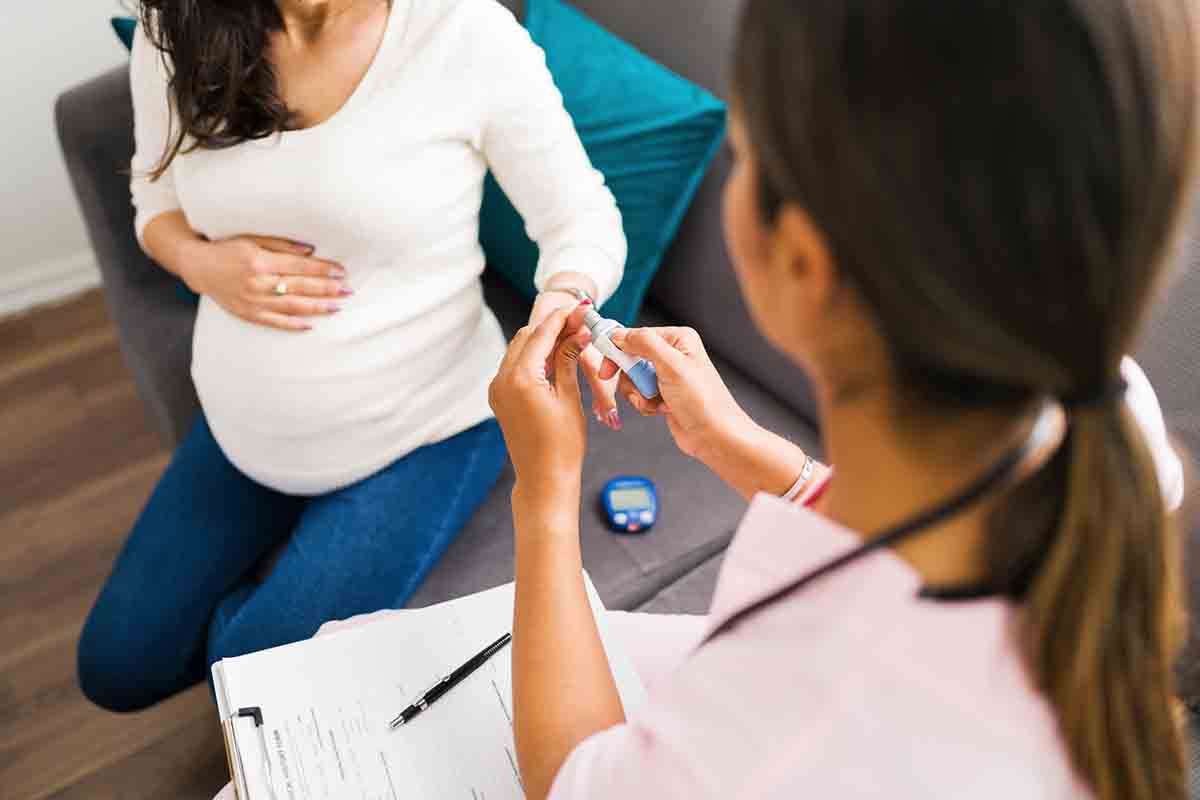The Best Diet for Gestational Diabetes: What To Eat (And Avoid)

Getting a diagnosis of diabetes during pregnancy can be scary, but changing your diet will help you and your baby stay healthy. Gestational diabetes mellitus (GDM) management may be challenging due to food cravings and aversions during pregnancy, but a registered dietitian or diabetes educator can help you come up with a meal plan you will enjoy that meets your nutritional needs to keep your blood sugar levels stable. A prenatal glucose test will determine whether or not you have gestational diabetes based on how high blood sugar levels are.
While all pregnant people need to follow a healthy diet, those with gestational diabetes need to be even more mindful. You will need to monitor your blood sugar levels and choose healthier foods to keep them stable. Avoid added sugar. Choosing whole foods like brown rice, healthy fats like fish and avocado, veggies, proteins, and complex carbohydrates can help you have a healthy pregnancy and deliver healthy babies. Getting safe exercise, like walking or swimming, and avoiding excessive weight gain is also important.
Related: Nutrition Before, During, and After Pregnancy
Early Signs of Gestational Diabetes

Your doctor will check your urine regularly throughout your pregnancy to look for traces of blood, sugar, and protein. Between 24 and 28 weeks pregnant, you will get your glucose test, where you fast and drink a high-sugar beverage before blood work to look for GDM. But there are some symptoms of diabetes you should be on the lookout for throughout pregnancy that might indicate the likelihood of gestational diabetes.
People with gestational diabetes have heavy fatigue, excessive thirst, and dry mouth. While these things can appear in a healthy pregnancy as well, they are worth mentioning to your doctor so they can be on the lookout for gestational diabetes.
You are at higher risk for developing GDM if you have a family history of diabetes. Being overweight or obese, over 25 years old, or of certain ethnicity can also increase your risk. but eating well and exercising to maintain a healthy weight, the condition can be prevented, or symptoms can be reduced. People at higher risk may receive additional testing earlier in their pregnancy.
Complications From Gestational Diabetes
Gestational diabetes can cause issues while you are pregnant and beyond. People who are diagnosed with gestational diabetes are at an increased risk of high blood pressure while pregnant, and in turn, have an elevated chance of developing life-threatening preeclampsia. This condition can lead to convulsions and seizures, fluid in the lungs, and developmental growth issues in babies.
While both GDM and preeclampsia typically subside once your baby is born, having GDM also puts you at increased risk for type 2 diabetes when you are older. The foods and lifestyle changes you make to stay healthy while pregnant should be continued to help reduce the chances of developing this disease later in life. Adding safe exercises and avoiding processed, high fat or sugar foods can reduce symptoms and side effects of GDM. Your doctor may also prescribe medication.
In addition to what you eat, how often you eat is just as important if you have gestational diabetes. It’s important to eat three meals per day, with healthy snacks like fruits and vegetables to keep your blood sugar stable. Your healthcare provider can answer any questions you have about the condition.
Best Foods to Eat with Gestational Diabetes

If you get a diagnosis of gestational diabetes, focus on eating a balanced diet where you count carbs. Non-starchy fruits and vegetables should be the focus, followed by lean protein, and a moderate amount of complex carbohydrates. Avoid deep-fried foods, which are high in saturated fat, and cook with olive oil or vegetable oil instead of butter. Sugar can be found naturally in fruits and other foods can be included in moderation, but leave out foods with added sugar.
This healthy eating routine will help you and your baby stay well. A big part of staying healthy after a GDM diagnosis is counting carbs to balance your blood glucose levels. You will need to monitor blood sugar levels, track the amount of carbohydrates you consume, and select smaller portion sizes.
Proteins for Gestational Diabetes
It’s important to reduce the amount of fat and sugar you consume, and this applies to your protein choices. Rather than having a burger or bacon, choose something lower in fat. Lean protein sources are important for people with this condition.
Think lean meats like chicken breasts, white fish, eggs, or ground turkey to get your two to three daily servings of protein. When preparing, cook them in olive oil rather than butter. Add seasoning without sugar for flavor.
Choosing Fruits and Vegetables
Fruit itself is an important part of a healthy diet, and though it is high in sugar, it can be consumed in moderation by people with GDM. You can have two to four servings of fruit daily.
Seek out moderate amounts of non-starchy vegetables, portioned complex carbohydrates, and whole grains. Fresh produce is great, but for meals, frozen vegetables like peppers, broccoli, peas, and spinach are convenient for days when you are too tired for chopping. Just make sure they are plain rather than sauced, to avoid added fat and sodium while meeting your three to five servings. If you want more flavor, adding spices is a good way to bring more depth to your meal without raising your blood sugar.
Carbohydrates for Gestational Diabetes

Rather than eating processed carbohydrate foods such as white bread, or simple carbs like white rice, choose complex carbohydrate whole grain items like brown rice and whole-grain bread. These will still need to be tracked for their carb content and eaten in moderation, but they are a much better choice than highly processed high carbohydrate foods.
Avoid cereals and oats for breakfast, which are high in carbohydrates, and opt instead for high protein items like eggs. Sweet potatoes and other starchy vegetables can be eaten in small amounts counted toward your daily carb intake. Rice, farro, barley, quinoa, and oatmeal are filling choices for adding to salads or eating as sides. Veggies like celery and baby carrots make healthy snacks. Legumes and beans, like lentils or black beans, are nutritious sources of protein that also count toward your carbohydrate intake, but your body digests them more slowly than other items in this category.
Dairy Intake During Pregnancy
Dairy products are another category to moderate in your diet. Some are high in protein, but they still have sugar. Avoid full-fat milk or yogurt with added sugar. Instead, pregnant women should choose skim milk or a plant-based beverage. Non-fat Greek yogurt is a good source of calcium and protein that is lower in sugar.
Some cheese can be eaten in a gestational diabetes diet. Seek out low-fat options like ricotta, mozzarella, or cottage cheese for a filling snack.
Satisfying Pregnancy Cravings
With nausea and pregnancy cravings that come with pregnancy, maintaining a gestational diabetes diet can feel difficult at times. While it can be tempting to give in to your cravings of high fat or sugar foods, like a large fry or cheeseburger, this is dangerous for you and your growing baby, and may end up covering the total amount of carbohydrates you’re allowed in a day, giving you empty calories and leaving you hungry shortly after.
You do not have to completely deprive yourself of foods you are in the mood for, however. Work to eat them in very small amounts, or find GDM-friendly alternatives. If you crave ice cream, having a small amount on occasion is possible if you count it toward your daily carbohydrates. You can also try to make your own frozen yogurt with fruit, greek yogurt, and a sweetener like Stevia. Busy moms-to-be can buy pre-made sugar-free froyo. While these are both healthier options, still keep these portions smaller since they will tend to be high in carbohydrates.
Rather than picking up a bag of chips, satisfy your craving for a crunchy snack with crispy chickpeas baked with olive oil and salt and pepper. Or dip some veggies in hummus for a filling snack or meal.
Staying Hydrated

You already need to drink plenty of fluids while pregnant since your body is working overtime for both you and your growing child, but water is even more important for pregnant women and people with gestational diabetes. Just as important as eating healthy foods is choosing healthy beverages to drink.
Investing in a large reusable water bottle that you like can help you stay on top of your hydration goals. There are many types available, from plastic bottles that allow you to see how much water you’ve had so far, to metal canteen-style ones that keep your drink cool regardless of the temperature outside. Whether or not you decide to breastfeed, investing in a good water bottle is important throughout and beyond pregnancy.
Fruit juices, which have health benefits, are not the best choice of beverage since their naturally sweet makeup can raise your blood sugar. Soda should be avoided. If you need the carbonation, try sparkling water, or occasionally, enjoy the diet version of your favorite beverage. If you want to sweeten your coffee or tea, choose a sugar-free sweetener like Stevia.
Make sure to consult a doctor about your specific gestational diabetes plan, and any other health concerns you may have. For more healthy meal ideas, check out: Daily Nutritional Needs for Pregnant Women.

